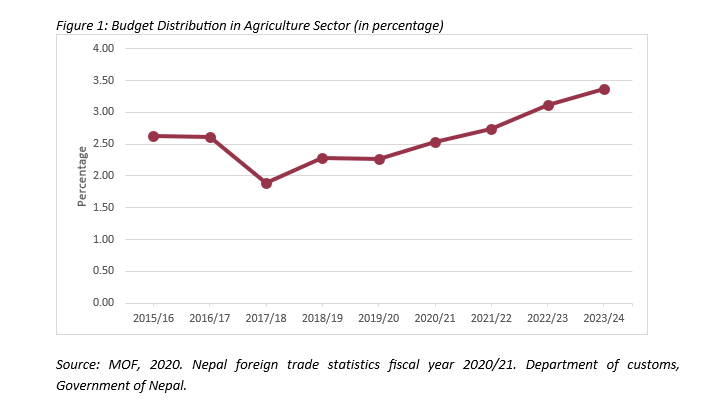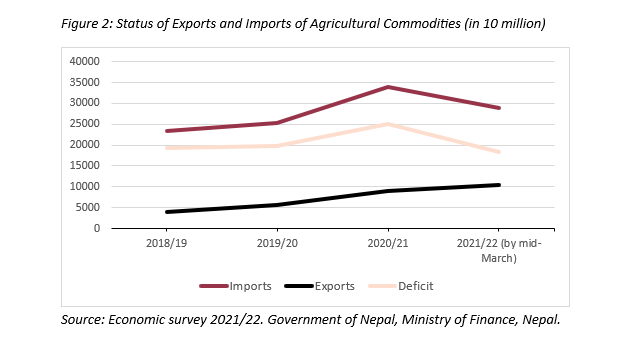Overview
Nepal is still largely an agrarian nation with around 62% of total population engaged in agriculture. The agriculture sector contributes to around one-third of the nation’s GDP and provides employment to two third of the population. But, the contribution to overall GDP has declined over time. Agriculture contributed to 36.64% of the GDP which then decreased to 23% by 2022. Similarly, the employment in agriculture has decreased from 73% in 2005 to 62% in 2021. Although the sector still contributes to a significant proportion of the overall GDP and a lot of population is engaged in agriculture, the government has allocated only NPR 58.98 billion (USD 445.21 million) for the agriculture sector in the fiscal year 2023/24 AD, out of a total size of NPR 1.751 trillion (USD 13.20 billion) which amounts to only 3.36% of total budget.
Current scenario of the government
Nepal is dependent on others for foods that it could produce on its own due to a lack of strong supportive policies despite having a lot of potential in this field. The priority of the government should be focused towards feeding the population with organic home-grown products, and reducing the increasing trade deficit through commercialization of products tailored to the climate and soil. But in reality, government investment, commercialization of agricultural practices, research and development, storage facilities are severely lacking.
Shrinking Workforce
The agriculture sector has remained stagnant over the years due to lack of attention from the government and the concerned stakeholders. The yield and crop production has decreased due to changing landscape, rainfall, and temperature directly leading to a rise in out-migration of workforce in search of better opportunities and income. According to the National Population Census 2021 preliminary result, 2.1 million Nepalis are living abroad which means one in every three households have at least one member absent or living outside of Nepal. Although there has been large increase in the in-flow of remittance, the hard-earned money is used up in buying foods to feed the families as it is actually cheaper to buy foods in the market than grow it in farms further widening the trade deficit. Nepal could save USD 2 billion (NPR 265 billion) every year if it could avoid the imports and decrease the agricultural trade deficit.
Inefficiency of FDIs and Business Development Strategies
SMEs in Nepal face difficulties in operation due to lack of adequate capital base, technology, information, and knowledge regarding marketing and opportunities. The government further adds up to it through high interest rates, high collateral requirements, information gap, and bureaucratic hurdles. According to Chandra Prasad Dhakal, President of FNCCI, Nepal invests only 1% of its total FDI on agriculture at present. The investors want security and return on their investment and Nepal must work towards providing an enabling environment in order to increase FDIs which would assist our farmers modernize farming with latest technologies.
Moreover, technological developments and commercialization are key factors for long-term investment in the industry. The government can realize the immense potential to address the gap in technical skill development and commercialization to increase investment in agriculture. Although agriculture contributes in the livelihood of significant proportion of the population, the potential for economic prosperity of the nation remains untapped due to poor business development strategies.
Investment Gap from BFIs
The agricultural sector of Nepal still falls far behind in being commercialized and mechanized due to a lack of significant investment. If we take a look into the data of agriculture census, the proportion of business holdings using agricultural credit to finance their farming is very low. Only 23% out of total holdings availed agricultural loan in 1991/92 AD. 24% of total holding availed for loan in 2001/02 AD which further decreased to 21.82% in 2010/11 AD.
The existing provision requires commercial banks to disburse minimum 15% of their total credit to agriculture sector. But the commercial and development banks are still below central bank’s mandate. Out of the total lending of commercial banks, only 13.1 percent (Rs.552.99 billion) lending has been in the agriculture sector.
Although number of financial institutions has increased in last two decades from 7 in 1990 to 111 as of mid-October 2023, agricultural financing is not yet satisfactory. Agriculture Census data shows that the highest sources of loans have been actually from cooperatives (39%), relatives (14%), women’s group (14%), and others. Moreover, there are 1,414,997 holdings (34%) seeking additional loans of which 37% are doing so for livestock farming, followed by agriculture inputs (32%), irrigation (13%), and so on.
Inefficiency of aids
The agriculture and livestock department are a key area of a lot of foreign aid and funds from the World Bank, Asian Development Bank (ADB) and IFAD (International Fund for Agriculture Development). However, rampant corruption, inefficient planning, and incompetent inspections have hindered in Nepal’s development projects wasting scarce resources. The aids meant for under-privileged people and under-served regions have been diverted to contractors, middlemen, consultants, and excessive employee benefits. The Project for Agriculture Commercialisation and Trade (PACT) received NPR 5.1 billion (USD 38.49 million) from the World Bank to improve the farming business and raise rural income. But the World Bank’s own investigation found that a majority of the budget was enjoyed by the middlemen and “fake farmers”. However no legal action has been taken by the government against the perpetrators who siphoned off the funds.
Increasing agricultural trade deficit
Nepal is naturally gifted through agricultural diversity with varied topographical, altitudinal and temporal conditions. But now, Nepal is highly dependent on imports to sustain its daily foods due to a growing population and rising income. Nepal highly imports staples like rice, vegetables, and fruits that could have easily been produced in our own fertile lands. While Nepal’s population has more than tripled from 9.4 million to nearly 30 million in the past 60 years, paddy output has only increased from 1.8 tonnes per hectare to 3.8 tonnes. This resulted in Nepal’s grain import reaching NPR 80 billion (USD 603.77 million) where rice alone comprised of NPR 50 billion (USD 377.36 million). A third of all the remittances earned from foreign employment are used up in importing foods while Nepal exports only NPR 64 billion (USD 483.02 million) worth of food items.
Nepal is a producer and exporter of tea and coffee, but it still imported NPR 9.5 billion (USD 71.70 million) worth of them. Half of the food imports are from India as the Indian farmers receive subsidies, seeds, fertilizers, technology, irrigation from their government which helps in producing crops at competitive prices. Hence, traditional Nepali variants are disappearing, replaced by cheaper, widely-available food variants.
Way forward
Nepal has a massive untapped opportunity in the agricultural sector and it can only be seized by establishing coordination between the government, banking sector, commercial agriculture, and business projects. Government investment is crucial in elevating rural livelihood and increasing agricultural productivity though agricultural support services, improved irrigation services for efficient water management, access to high-quality seeds, farm equipment, trainings in improved farming techniques, and value chain infrastructure. The government should further focus on sustainable practices of mixed farming systems (SIMFS) to decrease the increasing agricultural trade deficit. SIMFS has a positive effect on the environment also helping farmers to recover from droughts, floods, and even market failures. There must also be checks in the use of chemical fertilizers, investments in flood and erosion controls in the irrigation command areas, rural roads and bridges for connectivity and market access, and watershed conservation.
By improving the policy while also focusing on the efficient implementation of existing policies, Nepal can still improve the agricultural sector along with the overall economy of the country. It can be noted that despite the decline, the agricultural sector still has the highest share in the overall GDP and a large proportion of population are still dependent on it for their livelihood.
Mahotsav Pradhan holds a Bachelor’s degree in Economics (Honors) from the University of Delhi. Prior to joining Nepal Economic Forum as a Research Fellow, he has worked as Foreign Exchange Intern at Nepal Rastra Bank. He has a keen interest in development economics, with a passion for exploring the dynamics of policy analysis and international finance.







